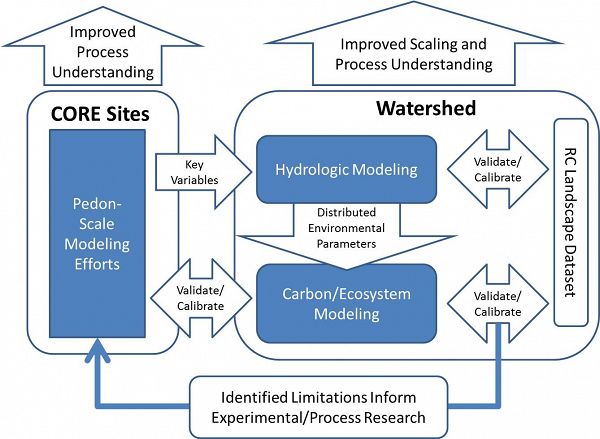Research Foci
The Reynolds Creek CZO is structured around three main research objectives to address the overarching hypothesis that soil environmental variables (e.g. soil water content, soil temperature, net water flux) measured and modeled at the pedon and watershed scale will improve our understanding and prediction of SC storage, flux, and processes.
- Conduct a Landscape Soil Carbon Survey
- Develop an Environmental Monitoring Network along an Elevation Gradient
- Develop Integrated Models to Test Soil Carbon Prediction
Landscape Soil Carbon Survey
-
Sample soils along relevant environmental gradients within RCEW to determine soil organic and inorganic carbon distribution
-
Analyze and archive soils across Reynolds Creek Experimental Watershed for other CZ properties
Environmental Monitoring Network
Establish 5 CORE sites along an elevation gradient from 250 mm to >1000 mm precipitation to calibrate Land Surface Ecosystem Models
• Net ecosystem exchange using eddy covariance (EC)
• Canopy transpiration and stand water use
• Aboveground biomass and limited net primary production (ANPP)
• Soil organic carbon stabilization/decomposition
• Soil respiration
Exports
• Stream and Groundwater Carbon Export: particulate organic carbon, dissolved organic carbon and inorganic carbon and groundwater
• Fire exports
Core sites and CZ measurements -net ecosystem exchange, soil respiration, litterfall, and soil organic carbon dynamics
Integrated Modeling
-
Develop modeling tools and products that convert point climate data to distributed datasets
-
Integrate field observational climate and biogeochemical data that represent critical carbon fluxes at pedon to landscape scale.
-
Evaluation of conceptual models of soil carbon behavior and associated interactions to promote up-scaling of mechanistic understanding to climate models
Core sites and CZ measurements -net ecosystem exchange, soil respiration, litterfall, and soil organic carbon dynamics
Expectations of soil inorganic and organic carbon distributions
Integrated modeling used to combine detailed CORE measurements and distributed fine resolution watershed scale forcing data to predict soil carbon
Explore Further



